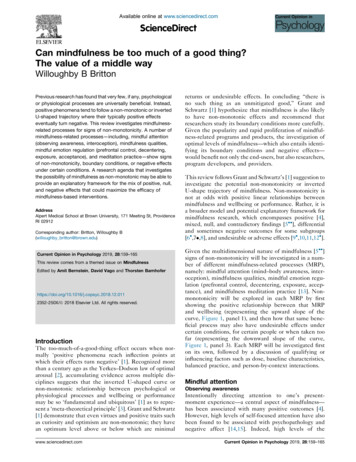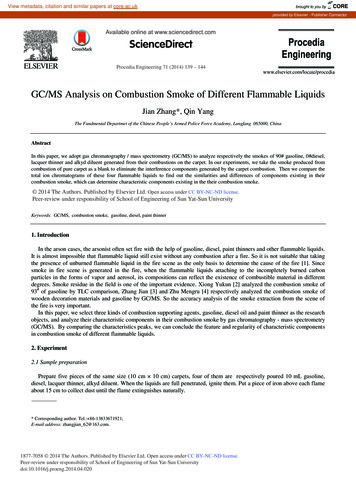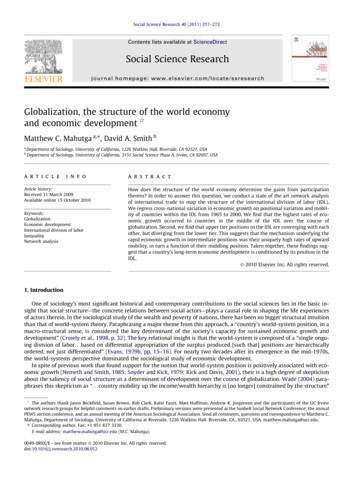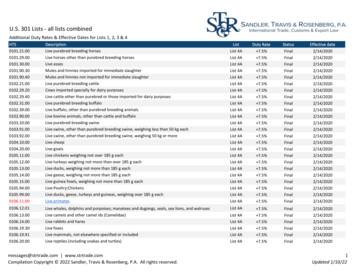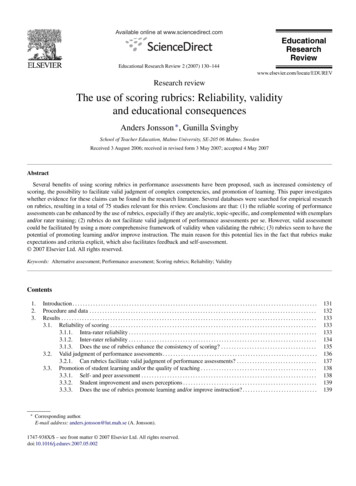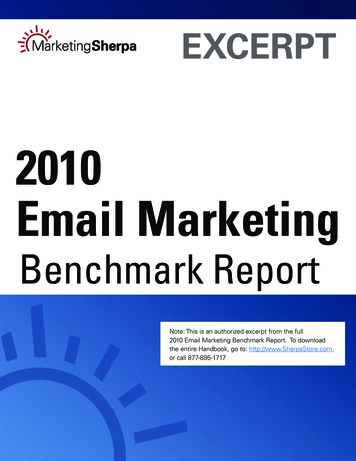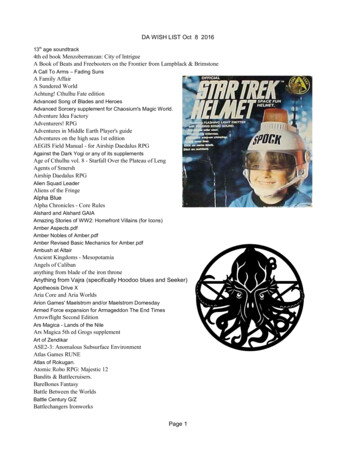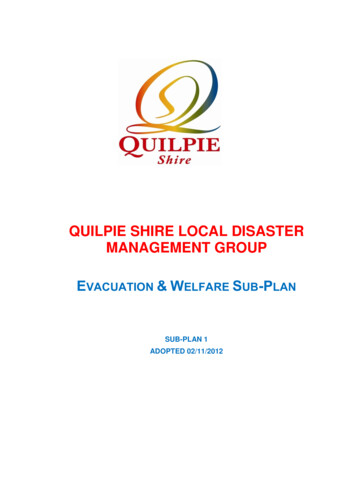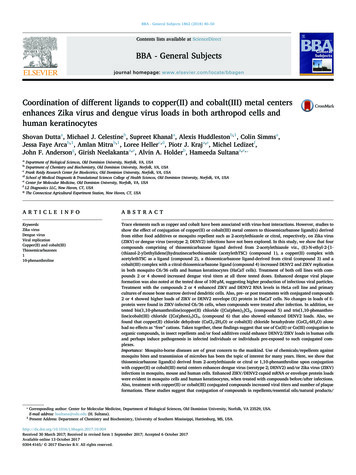
Transcription
BBA - General Subjects 1862 (2018) 40–50Contents lists available at ScienceDirectBBA - General Subjectsjournal homepage: www.elsevier.com/locate/bbagenCoordination of different ligands to copper(II) and cobalt(III) metal centersenhances Zika virus and dengue virus loads in both arthropod cells andhuman keratinocytesMARKShovan Duttaa, Michael J. Celestineb, Supreet Khanala, Alexis Huddlestonb,1, Colin Simmsa,Jessa Faye Arcab,1, Amlan Mitrab,1, Loree Hellerc,d, Piotr J. Kraja,e, Michel Ledizetf,John F. Andersong, Girish Neelakantaa,e, Alvin A. Holderb, Hameeda Sultanaa,e,⁎aDepartment of Biological Sciences, Old Dominion University, Norfolk, VA, USADepartment of Chemistry and Biochemistry, Old Dominion University, Norfolk, VA, USAFrank Reidy Research Center for Bioelectrics, Old Dominion University, Norfolk, VA, USAdSchool of Medical Diagnostic & Translational Sciences College of Health Sciences, Old Dominion University, Norfolk, VA, USAeCenter for Molecular Medicine, Old Dominion University, Norfolk, VA, USAfL2 Diagnostics LLC, New Haven, CT, USAgThe Connecticut Agricultural Experiment Station, New Haven, CT, USAbcA R T I C L E I N F OA B S T R A C TKeywords:Zika virusDengue virusViral replicationCopper(II) and ce elements such as copper and cobalt have been associated with virus-host interactions. However, studies toshow the effect of conjugation of copper(II) or cobalt(III) metal centers to thiosemicarbazone ligand(s) derivedfrom either food additives or mosquito repellent such as 2-acetylethiazole or citral, respectively, on Zika virus(ZIKV) or dengue virus (serotype 2; DENV2) infections have not been explored. In this study, we show that fourcompounds comprising of thiosemicarbazone ligand derived from 2-acetylethiazole viz., carbothioamide (acetylethTSC) (compound 1), a copper(II) complex withacetylethTSC as a ligand (compound 2), a thiosemicarbazone ligand-derived from citral (compound 3) and acobalt(III) complex with a citral-thiosemicarbazone ligand (compound 4) increased DENV2 and ZIKV replicationin both mosquito C6/36 cells and human keratinocytes (HaCaT cells). Treatment of both cell lines with compounds 2 or 4 showed increased dengue viral titers at all three tested doses. Enhanced dengue viral plaqueformation was also noted at the tested dose of 100 μM, suggesting higher production of infectious viral particles.Treatment with the compounds 2 or 4 enhanced ZIKV and DENV2 RNA levels in HeLa cell line and primarycultures of mouse bone marrow derived dendritic cells. Also, pre- or post treatments with conjugated compounds2 or 4 showed higher loads of ZIKV or DENV2 envelope (E) protein in HaCaT cells. No changes in loads of Eprotein were found in ZIKV-infected C6/36 cells, when compounds were treated after infection. In addition, wetested bis(1,10-phenanthroline)copper(II) chloride ([Cu(phen)2]Cl2, (compound 5) and tris(1,10-phenanthroline)cobalt(III) chloride ([Co(phen)3]Cl3, (compound 6) that also showed enhanced DENV2 loads. Also, wefound that copper(II) chloride dehydrate (CuCl2·2H2O) or cobalt(II) chloride hexahydrate (CoCl2·6H2O) alonehad no effects as “free” cations. Taken together, these findings suggest that use of Cu(II) or Co(III) conjugation toorganic compounds, in insect repellents and/or food additives could enhance DENV2/ZIKV loads in human cellsand perhaps induce pathogenesis in infected individuals or individuals pre-exposed to such conjugated complexes.Importance: Mosquito-borne diseases are of great concern to the mankind. Use of chemicals/repellents againstmosquito bites and transmission of microbes has been the topic of interest for many years. Here, we show thatthiosemicarbazone ligand(s) derived from 2-acetylethiazole or citral or 1,10-phenanthroline upon conjugationwith copper(II) or cobalt(III) metal centers enhances dengue virus (serotype 2; DENV2) and/or Zika virus (ZIKV)infections in mosquito, mouse and human cells. Enhanced ZIKV/DENV2 capsid mRNA or envelope protein loadswere evident in mosquito cells and human keratinocytes, when treated with compounds before/after infections.Also, treatment with copper(II) or cobalt(III) conjugated compounds increased viral titers and number of plaqueformations. These studies suggest that conjugation of compounds in repellents/essential oils/natural products/⁎1Corresponding author: Center for Molecular Medicine, Department of Biological Sciences, Old Dominion University, Norfolk, VA 23529, USA.E-mail address: hsultana@odu.edu (H. Sultana).Present Address: Department of Chemistry and Biochemistry, University of Southern Mississippi, Hattiesburg, MS, Received 30 March 2017; Received in revised form 1 September 2017; Accepted 6 October 2017Available online 13 October 20170304-4165/ 2017 Elsevier B.V. All rights reserved.
BBA - General Subjects 1862 (2018) 40–50S. Dutta et al.food additives with copper(II) or cobalt(III) metal centers may not be safe, especially in tropical and subtropicalplaces, where several dengue infection cases and deaths are reported annually or in places with increased ZIKVcaused microcephaly.1. Introductionand full pants and insect repellents to avoid the mosquito bites. In highendemic areas, it becomes important to use repellents on a routine basisto prevent bites from infected mosquitoes.Several reports suggest that trace elements such as copper and cobalt play an important role in the host immunomodulatory activitiesduring viral infections [23,24]. Any changes in the levels of trace elements could impact disease severity [25]. Essential oils from plants andherbs can inactivate enveloped and non-enveloped viral replication andexhibit antiviral activities [26–29]. Due to the strong antiviral andantimicrobial activities, novel citral-based compounds (the well-knownnatural insect repellent) are developed continuously [26–29]. Studiesthat show the effect of conjugation of citral-based compounds withdifferent trace elements on ZIKV and dengue virus replication has notbeen explored. The purpose of the current study is to analyze the effectsof copper(II) and cobalt(III) metal conjugations with organic compounds (that are used in repellents or food additives) on DENV2/ZIKVinfections. The four compounds analyzed in this study are selectedbased on the structural activity relationship (SAR) in order to determinethe best efficacy in inhibition of the virus. It has been reported thatwhen “free” thiosemicarbazone ligands are coordinated to a metalcenter, the efficacy in the activity is enhanced in comparison to the“free” ligands. In this study, we show that treatment of mosquito (C6/36 cells) and human keratinocytes (HaCaT cells), HeLa cells and primary cultures of mouse bone marrow-derived dendritic cells withthiosemicarbazones coordinated to Cu(II) or Co(III) metal centers enhances ZIKV and DENV2 infections. Our data suggests that use of coordinated version with metal centers in the repellent formulations mayaid better replication of ZIKV and DENV2 in the human cells upontransmission by the biting mosquitoes.Insect bites, food or crop damage and transmission of pathogens tohumans, animals and plants has led to the extensive use of insecticides,pesticides and insect attractants or repellents [1,2]. Use of these substances has substantially been increased in military personnel and inagriculture or horticulture practices. Over a decade, several of thesechemicals have been used extensively in all parts of the world. Somesynthetic compounds or chemicals are of major concern to the environment and human health and they have been withdrawn due to theadverse effects and serious human health hazards [3–8]. One of themost recent study tested that several of the repellents including citronella candles had no effects and did not reduced mosquito attractionto humans [9]. The disadvantages of some insecticides have promotedthe use of plant-based essential oils and their derived natural products,belonging to several herb species that poses repellent activities [7,10].Some of the essential oils, herbal skin products and non-natural inorganic insecticides (the contact insecticides that are toxic to insectsupon direct contact) have been shown to contain metals such as arsenates, copper, cobalt and fluorine compounds in small amounts andsulfur as a major component [11]. Also, both copper sulfate and cobaltchloride has been shown to improve the varieties in rice and vegetablesthat are mostly consumed in Australia and some parts of Asia [12]. Inaddition, complex mixtures of volatile organic compounds producedfrom plant-based essential oils or natural products such as citral havebeen extensively used as repellents to prevent transmission of humanpathogens through biting arthropods such as mosquitoes [7,10,13].Mosquitoes are the primary vectors responsible for the transmissionof arthropod-borne flaviviruses that cause microcephaly (Zika Virus),dengue hemorrhagic fever, yellow fever, West Nile neuroinvasive disease (WNND) and Japanese encephalitis. With regard to the globalimpact from arthropod-borne diseases, dengue is the most importanthuman pathogen (that exist as four serotypes; DENV-1, 2, 3 and 4) thatshould be addressed promptly. According to the 2009 WHO criteria,dengue cases have been classified according to the levels of severity.Dengue infections without warning signs or with warning signs (such asabdominal pain, persistent vomiting, fluid accumulation, mucosalbleeding, liver enlargement, increasing hematocrit with decreasedplatelet numbers and lethargy) were considered as less severe.However, dengue infections with severe plasma leakage, bleeding ororgan failures were considered as severe cases [14,15]. Approximately20,000–25,000 deaths and 50–100 million dengue infections with500,000 hospitalizations are reported, annually [16]. Also, there are nofully effective vaccines available for human use and prevention ofdengue [17,18]. Nevertheless, recently, WHO immunization group(Strategic Advisory Group of Experts; SAGE) has recommended the useof partially effective dengue vaccine (a live attenuated tetravalentdengue vaccine developed by Sanofi Pasteur; CYD-TDV, named Dengvaxia) that has been licensed and used in 11 countries including Brazil,Mexico, Singapore, Thailand and Indonesia [19]. Related to dengue,Zika virus (ZIKV) is an emerging infectious agent transmitted andspread by the daytime active Aedes mosquitoes, such as A. aegypti andA. albopictus. ZIKV can be transmitted by blood transfusions, sexual andplacental leakage from the mother to the fetus [20,21]. An importantpublic health concern has been declared due to global epidemic of ZIKVinfections. The association between ZIKV infection during pregnancyand intrauterine fetal infection, microcephaly, brain damage, congenital malformation syndrome and evidences from laboratory modelsof fetal infections are reported [20–22]. The best prevention practice isthe use of mosquito nets, protective clothing such as long-sleeve shirts2. Materials and methods2.1. Synthesis of the ligands and the compoundsAnalytical or reagent grade chemicals were used throughout thisstudy. All the chemicals including solvents were obtained from SigmaAldrich (St. Louis, MO, U.S.A.) or other commercial vendors, and usedas received. Microanalyses (C, H, N) were performed by IntertekChemical and Pharmaceuticals, 291 Route 22 East, Salem IndustrialPark, Building #5, Whitehouse, NJ 08888, U.S.A. The FT IR (FourierTransform infrared) spectrum was acquired in the range of4000–400 cm 1 using the Attenuated Total Reflectance (ATR) accessory (with a diamond crystal) on a Nicolet 6700 FT IR spectrometer. 1Hnuclear magnetic resonance (1H NMR) spectra were acquired on aBruker AVANCE III 400 MHz spectrometer with deuterated dimethylsulfoxide‑d6 (DMSO‑d6) as solvent. All 1H NMR spectra were processedwith the Spectrus Processor 2012 software, which is available fromAdvanced Chemistry Development (ACD, Inc., 8 King Street East, Suite107, Toronto, Ontario M5C 1B5, Canada).The “free” salts and complexesThe “free” CuCl2.2H2O and CoCl2.6H2O salts were obtained fromSigma-Aldrich Corporation.Synthesis of ecarbothioamide(acetylethTSC) 1 and [Cu(acetylethTSC)Cl]Cl·0.25C2H5OH 2 (Compounds 1and 2, dene]hydrazinecarbothioamide(acetylethTSC) 1 was synthesized and characterized as by Lewis et al.;[30] while the complex, [Cu(acetylethTSC)Cl]Cl·0.25C2H5OH 2 (where41
BBA - General Subjects 1862 (2018) 40–50S. Dutta et al.2.3. RNA extraction, cDNA synthesis and Quantitative Real-Time PCR (QPCR) analysisacetylethTSC ecarbothioamide) was synthesized and characterized as bySandhaus et al. [31]Total RNA from 1 105 of either C6/36 cells or HaCaT cells, firsttreated with the compounds (for 24 h) using different doses (1, 10 or100 μM) followed by infection with DENV2/ZIKV (MOI 1; 24 h postinfection) or post-treated (24 h) with respective compounds (indicateddoses) after DENV2/ZIKV infection (MOI 1; 24 h) were generated usingAurum Total RNA Mini kit (BioRad, Hercules, CA) following manufacturer instructions. RNA was converted to cDNA using iScript cDNAsynthesis kit (BioRad). The generated cDNA was used as template forthe amplification of DENV2/ZIKV; capsid/NS5 transcripts, respectively,from cDNA with primers as described [36,37]. As an internal controland to normalize the amount of template, either mosquito or mouse orhuman beta actin amplicons were quantified using published primers[36]. Q-PCR data showing DENV2/ZIKV loads were presented by normalizing expression of capsid/NS5 gene transcripts to either mosquitoor mouse or human beta actin. Q-PCR was performed using iQ-SYBRGreen Supermix and CFX96 touch System (BioRad). Standard curveswere prepared using 10-fold serial dilutions starting from 1 to0.00001 ng/μl of known quantities of DENV2/ZIKV, capsid/NS5, andrespective beta-actin fragments. Following are the oligonucleotidesused in this study: DENV2 capsid, 5′ AATATGCTGAAACGCGAGAGAAACCGCG 3′ and 5′ CTCTTCAGTATCCCTGCTGTTGG 3′; ZIKV NS5, 5′AARTACACATACCARAACAAAGTGGT 3′ and 5′ TCCRCTCCCYCTYTGGTCTTG 3′; human actin, 5′ AGCCTCGCCTTTGCCGA 3′ and 5′ CTGGTGCCTGGGGCG 3′; mouse actin, 5′ CCCTAGGCACCAGGGTGTGA 3′and 5′ GGGGTGTTGAAGGTCTCAAACA 3′; mosquito actin, 5′ CCATGTACGTCGCCATCCA 3′ and 5′ GCGGTGGCCATTTCCTG 3′; human IFNbeta, 5′ CAGCAATTTTCAGTGTCAGAAGCT 3′ and 5′ TCATCCTGTCCTTGAGGCAGT 3′; and human TNF-alpha, 5′ CCCAGGCAGTCAGATCATCTT 3′ and 5′ TCTCAGCTCCACGCCATT 3′.Synthesis of citralEtTSC·0.25C2H5OH 3 (Compound 3)Citral (3.0 g, 3.377 ml, 20 mmol) and 4-ethyl-3-thiocarbazide(2.4 g, 20 mmol) were mixed in a 250 ml round bottom flask, followedby anhydrous ethanol (100 ml) and five drops of glacial acetic acid. Thereaction mixture was refluxed with stirring for three hours and evaporated to dryness. The resulting oil was allowed to stay at roomtemperature until it solidified to leave the resulting product.Yield 4.8 g (91%). Calc. C13.5H24.5N3O0.25S, C, 61.21; H, 9.32; N,15.86%. Found: C, 60.82; H, 9.34; N, 15.76%. FT IR (ν/cm 1): 3164(m) ( N1H), 3054 (m) ( N2H), 1059 (m) (N-N), 1543 (m) (TSC(C N)), (1296) (m) and (813) (m) (C S). 1H NMR (400 MHz;DMSO‑d6); δH 1.16 (t, Jt 7.10 Hz, 3H, –CH3), 2.42 (s, 3H,CH3CH N), 3.61 (d, 2H, CH2), 7.79 (d, Jd 3.21 Hz, CHar), 7.88 (d,Jd 3.19 Hz, CHar), 8.08 (d, Jd 3.24 Hz, CHar), 8.30 (s, H, aminicNH), 10.58 (s, 1H, hydrazinic-NH), and 13.2 (s, H-bonded hydrazinicNH) ppm.Synthesis of [Co(phen)2(citralEtTSC)](NO3)3·0.25H2O·1.5C2H5OH 4(Compound 4)At first, [Co(phen)2CO3]Cl·5H2O was synthesized using the procedure as reported by Kashiwabara et al. [32]. First, we prepared [Co(phen)2(H2O)2](NO3)3, then [Co(phen)2(H2O)2](NO3)3·2H2O was synthesized by the acid hydrolysis of [Co(phen)2CO3]Cl·5H2O using thesynthesis as reported by ye et al. [33]. Finally, [co(phen)2(H2O)2](NO3)3·2H2O was placed in an oven set at 110 C for 24 h in order toproduce anhydrous [Co(phen)2(H2O)2](NO3)3. [Co(phen)2(H2O)2](NO3)3 (0.80 g, 1.2 mmol) and citralEtTSC·0.25C2H5OH (0.32 g,1.2 mmol) in anhydrous ethanol (410 ml) were refluxed in a 500 mlround bottom flask with stirring at 110 C under argon for 24 h. Themixture was rotary evaporated to dryness. The solid was washed withether and collected. Yield 1.0 (91%)Calc. C40H48.5CoN10O10.75S, C, 51.53; H, 5.24; N, 15.02%. Found: C,51.53; H, 4.57; N, 14.57%.Complexes 5 and 6, [Cu(phen)2]Cl2 and [Co(phen)3]Cl3 were synthesized respectively as by the literature procedure [34,35].All tested compounds were completely solubilized in DMSO andwere prepared as 1 ml of 100 mM solutions (compounds 1, 3 and 4) or20 mM stocks of compound 2 (due to low solubility issues) or 0.1 mMstock of Compound 5 and 6 were prepared. The indicated doses 1, 10and 100 μM were prepared from the stock solutions and used as testdoses throughout the study. The compound stocks and dilutions werekept as recommended by the previous studies.2.4. Western blottingTotal proteins from 1 105 of either C6/36 cells or HaCaT cellsinfected with DENV2 (MOI 1; 24 h post infection) or with ZIKV (MOI 1or 5; for 24 h) and then followed by treatments with respective compounds at different doses (1, 10, 100 μM) for another 24-h period orvice versa (treated with compounds and then infected; in a similarmanner as described above) were collected in ice-cold modified RIPAbuffer (G-Biosciences, BioExpress, Kaysville, UT). Total proteins wereestimated using BCA kit (Pierce, ThermoScientific). Total lysates fromC6/36 or HaCaT cells (25 μg) were separated on 4–20% gradient or12% SDS-PAGE gels (NuSep; BioExpress). Following gel electrophoresis, blotting (on nitrocellulose membranes) and blocking (5% milkbuffer or BSA NAP-blocker solution; G-Biosciences, BioExpress) wasprocessed and blots were incubated with 4G2 monoclonal antibody(non-reducing conditions), obtained from Dr. Michel Ledizet, L2Diagnostics, Inc. Monoclonal Anti-Flavivirus Group Antigen, Clone D14G2-4-15 (Catalog Number; NR-50327), antibody obtained from BEIresources was used to detect ZIKV E-protein. Mouse monoclonal IgGconjugated with HRP (Santa Cruz Biotechnologies, Dallas, TX) wereused as secondary antibodies for detection. Total protein profiles serveas loading controls and not for comparison between the compounds.The differences in protein profile gels are due to use of either stain-freegel images after run, or staining of gels with either colloidal Coomassieblue or R-250 Coomassiee blue solutions. ECL detection of antibodybinding was performed with WesternBright ECL kit (Advansta,BioExpress). Blots were scanned using Chemidoc MP imaging systemand recommended Image Lab software from the manufacturer(BioRad).2.2. Cell culture and infectionMosquito (C6/36) cells and Vero (African Green Monkey kidney)cell line were purchased from American Type Culture Collection(ATCC). Human keratinocytes (HaCaT cells) were obtained from Dr.Loree Heller, Center for Bioelectrics. C6/36 or HaCaT cells were platedin a 24/12 well plate at a density of 1 105 cells per well in completeMEM or DMEM medium containing 10% FBS, L-glutamine and Pen/Strep and kept at either 30 C or 37 C with 5% CO2, respectively. Cellswere either treated with respective compounds 1, 2, 3 or 4 (with indicated doses; 1, 10 or 100 μM) for 24 h before or after infection withZIKV/DENV2 (multiplicity of infection, MOI 1) for 24-h. Compounds5 and 6 or the “free” Cu(II) and Co(II) salts (with indicated doses; 1, 10or 100 μM) were also treated for 24 h followed by infection withDENV2 (multiplicity of infection, MOI 1) for another 24-h. ZIKVstrain, VR-1838, was obtained from ATCC or DENV2 (Serotype 2); ElSalvador TVP2176 strain was obtained from Dr. John F. Anderson,Connecticut Agricultural Experiment Station. DMSO-treated or untreated (uninfected or infected) cells served as controls.2.5. Virus titration assaysFor the titration assay, briefly, C6/36 or HaCaT cells were seeded42
BBA - General Subjects 1862 (2018) 40–50S. Dutta et al.into 96 well plates and at a density of 1 105 cells/well in 225 μl ofeither MEM or DMEM complete medium with 10% FBS, pen/Strep andL-Glutamine. Cells were incubated overnight at either 30 C or 37 Cwith 5% CO2, respectively. Cells were treated with respective compounds 1–4 at doses of 1, 10 or 100 μM (for 24 h), followed by infectionwith DENV2 (MOI 1) for another 24 h. Each of the compound and respective doses were kept as six independent replicates in addition to theuninfected, infected and infected-DMSO treated controls. Following24 h post-infection, cells were fixed with acetone-PBS mixture (3:1) for20 min at 20 C. Immediately after fixation, plates were air dried andwashed with 1 PBS and blocked with 5% FBS-PBS-0.05% SodiumAzide for 15 min at RT. After blocking, cells were incubated with 4G2monoclonal antibody for overnight at 4 C. Cells were washed threetimes with PBS and incubated with Alexa-594 labeled mouse secondaryantibody for 1 h at RT, followed by washes (3 ) with PBS. Plates n/Thermoscientific) and cells were scored for fluorescence or the presenceor absence of infection in comparison to the positive (Infected and infected-DMSO-treated) or negative (uninfected) controls. Percentageswere calculated from ratio of fluorescent cells to no fluorescent cellsand as manual countings from eight microscopic fields. We collectedeight images for each treatment and respective doses and representativeimages are shown in Supplementary information. Infection indicated byred fluorescence was determined as average from collected images andpercentages were plotted in comparison to the infected-DMSO-treatedcontrols.BE-proteinC6/36 mosquito cells-DENV2 loadsPlaque assays were performed as described [36]. For the plaqueformation assay, briefly, Vero cells were seeded into 6 well plates and ata density of 1.5 106 cells/well in DMEM complete medium with 10%FBS. Cells were incubated overnight at 37 C with 5% CO2 and thentreated with compounds 1–4 at doses of 100 μM (for 24 h), followed byinfection with DENV2 (MOI 1) for 2 h. Following post-infection,medium was removed and warm 2% Seaplaque agarose (Lonza) overlaywith complete DMEM media (1:1 ratio) containing antibiotic and antimycotics solution (1% each; Sigma) was added. Plates were incubatedfor additional 5 days, at 37 C and 5% CO2. After an incubation period,plaques were stained with 0.03% of Neutral Red (Sigma) for 4 h; stainwas removed to count plaques. Each of the compounds (at the dose of100 μM) was kept as two independent replicates in addition to thecontrols (infected and infected-DMSO treated). Representative imagesare shown for each compound and controls. Plaques counting areaverages from three independent readouts.2.7. Isolation and culturing of mouse bone marrow-derived dendritic CellsBone marrow cells were isolated from femurs and tibias of C57BL/6mice, and red blood cells were lysed with ammonium chloride.Remaining cells were plated at a density of 7 106 per 100-mm cellculture dish in 10 ml of α-MEM media (HyClone) supplemented with10% Fetal Bovine Serum (Atlanta Biologicals), 2 mM L-glutamine,UTIUIIDMSOComp 1 ( M)110100Comp 2 ( M)110 100Comp 3 ( M)110100Comp 4 ( M)M110100DHaCaT cells-DENV2 loadsTotal Protein profileCE-proteinTotal Protein profileA2.6. Viral plaque formation assayFig. 1. Treatment with organic compounds post infection enhances dengue virus loads. Q-PCR and immunoblotting analysis showing the DENV2 capsid transcripts or envelope E-proteinloads in C6/36 mosquito cells (A & B) or human keratinocytes (HaCaT cells) (C & D) infected with DENV2 (MOI 1) for 24 h followed by treatment with compounds 1–4 at differentconcentrations (1, 10 and 100 μM) for another 24 h, respectively. DENV2 capsid mRNA transcript levels (A & C) were determined by Q-PCR upon treatment with compounds incomparison to the infected-DMSO controls. UT indicates untreated cells; M shows marker lane and μM means micro molar. Uninfected (UI) or infected (I) cells treated with DMSO areincluded as controls. DENV2 E- protein was detected in panels B & D and upper band indicates glycosylated form. Total protein profiles are shown as loading control and not forcomparison. The differences in protein profiles are due to use of Colloidal Coomassie blue staining in panels with compounds 1 and 4 and Coomassie blue R-250 staining solution in panelswith compounds 2 and 3. Statistics was performed using the Student's two-tailed test. The P 0.05 is indicated with an asterisk to show significance in comparison to DMSO-treatedcontrol and error bars indicate standard deviation. (For interpretation of the references to colour in this figure legend, the reader is referred to the web version of this article.)43
BBA - General Subjects 1862 (2018) 40–50S. Dutta et al.3. Resultsdextrose, essential and non-essential amino acids, sodium captoethanol.Granulocyte-macrophage colony- stimulating factor (GM-CSF;Peprotech; 5 ng/ml) was added at the time of plating, and again after72 h of incubation. Experiments using animals were in accordance withprotocols from the Institutional Animal Care and Usage Committee (asper the approved protocol 14–009). For infection and treatment withcompounds, we re-plated dendritic cells into 24 well plates as 1 105cells/ml in each well and infected with either DENV2/ZIKV (MOI 1),respectively. After 24 h post infection, dendritic cells were treated withall four compounds at different doses (1, 10, 100 μM) for another 24 h,and collected for RNA extractions.3.1. Synthesis and schemes of compounds(E)-N-ethyl-2-[1-(thiazol-2-yl) ethylidene]hydrazinecarbothioamide(acetylethTSC) compound 1 was synthesized as described by Lewiset al.; [30] while the compound 2, [Cu(acetylethTSC)Cl]Cl·0.25C2H5OH2 (where acetylethTSC ecarbothioamide) was synthesized as described by Sandhauset al. [31] (Scheme 1, Supplementary Information). Compounds 3 and 4were synthesized as described in (Scheme 2, Supplementary Information). The 1H NMR spectrum of compound 3 (citralEtTSC·0.25C2H5OH)is shown in Supplementary Fig. 1A. The thiosemicarbazone ligand derived from 2-acetylethiazole (compound 1), 2-acetylthiazole thiosemicarbazone ligand‑copper(II) complex (compound 2), had been synthesized in [31]. Compounds 3 and 4 that are thiosemicarbazone ligandsderived from citral without (compound 2) or with Co(III) complex(compound 4), respectively, were synthesized in this study as shown inSchemes 1 and 2. Complexes 5 and 6, [Cu(phen)2]Cl2 and [Co(phen)3]Cl3, respectively, were synthesized in this study as by the literature procedure [34,35]. Schemes 3 and 4 in Supplementary information show the synthesis of complexes 5 and 6. The 1H NMR2.8. StatisticsStatistical significance of differences observed in data sets wasanalyzed using Prism6 software (GraphPad, La Jolla, CA) and MicrosoftExcel. For data to compare two means, the non-paired, two-tail Studentt-test was performed for all analysis. P values of 0.05 were considered significant in all tests, error bars represent mean ( SD) values.Statistical test and P values are shown.Virus Titration and Plaque Formation assayBC6/36 mosquito cells-DENV2 loadsCHaCaT cells-DENV2 loadsDPlaque Assay PlateInfectedInfected-DMSOCompound 2Compound 3Plaque Assay countCompound-1 (100 M)Compound 4 (100 M)Fig. 2. Treatment with compounds 2 and 4 increase DENV2 infectious titers and viral plaques. Virus titration assays in mosquito (A) and HaCaT (B) cells showing percentages of infectedcells upon 24-h treatment with compounds (1–4) at doses of 1, 10 and 100 μM, followed by infection with DENV2 (MOI 1) for another 24 h. Percentage of infected cells were analyzedfrom eight different microscopic fields in comparison to the infected-DMSO-treated controls and plotted as percentages. (C) Plaque formation assay performed in Vero cells treated withcompounds 1–4 at 100 μM for 24 h followed by infection with DENV2 (MOI 1) for 2 h and incubation for another 5 days to form plaques are shown. A representative image of a 6-wellplate with plaques from different groups is shown. Plaques from compounds treated groups were compared to the infected-DMSO-treated control. Ruler at the bottom determines the scalefor the plaques from the representative image. (D) Quantitative assessment of number of plaques from compound (1–4) treated (100 μM) and infected-DMSO-treated is shown.Representative data from two independent experiments is shown. P value determined by Student's two-tail t-test is shown.44
BBA - General Subjects 1862 (2018) 40–50S. Dutta et al.CuCl2.2H2O and CoCl2.6H2O salts independently in both mosquito andHaCaT cells. We found that in both cell lines the salts alone did notenhanced the DENV2 loads at the similar treatments (with tested dosesof 1, 10, 100 μM) and infection times (Supplementary Fig. 2C and 2D).This data suggested that Cu(II) or Co(II) salts alone has no effects as freecations.spectrum of complexes 5 and 6 and [Co(phen)3]Cl3 are shown in Supplementary Fig. 1B and 1C. The methods used to synthesize thesecompounds are validated and are routinely been used in the biochemistry laboratory [31].3.2. Thiosemicarbazone and 1, 10-Phenanthroline ligands conjugated withCu(II) or Co(III) complexes enhance dengue virus loads3.3. Cu(II) or Co(III) metal centers with thiosemicarbazone ligands enhanceproduction of infectious viral particlesWe determined the dengue virus loads in order to investigate anyinterference of these compounds in virus inhibition. C6/36 cells orHaCaT cells were infected with DENV2 (MOI 1) for 24 h, followed by24-h of incubations with respective compounds at different doses of 1,10 and 100 μM concentrations. Q-PCR data showed that treatment ofC6/36 cells wit
d School of Medical Diagnostic&Translational Sciences College of Health Sciences, Old Dominion University, Norfolk, VA, USA e Center for Molecular Medicine . Department of Biological Sciences, Old Dominion University, Norfolk, VA 23529, USA. 1 Present Address: Department of Chemistry and Biochemistry . Building #5, Whitehouse, NJ 08888, U.S .
